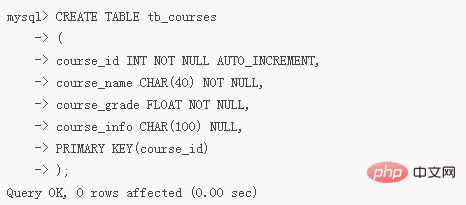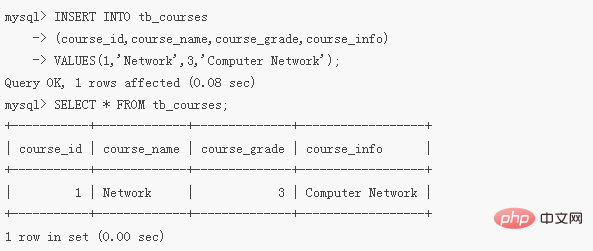 Common Problem
Common Problem
 Can the create statement be used to create a table structure and append new records?
Can the create statement be used to create a table structure and append new records?
Can the create statement be used to create a table structure and append new records?
cannot. The function of the CREATE statement is to create a table structure, but it cannot append new records. You can use the INSERT statement to append new records. The CREATE statement can be used to create a new table in the database and specify the attributes and constraints of the data columns; however, the newly created table is an empty table and requires the use of the INSERT statement to append new records. The INSERT statement is used to insert one or more rows of tuple data into an existing table in the database.

The operating environment of this tutorial: windows7 system, mysql8, Dell G3 computer.
"The create statement is used to create a table structure and append new records" is wrong.
The function of the CREATE statement is to create a table structure, but it cannot append new records. You can use the INSERT statement to append new records.
CREATE statement
The CREATE statement can be used to create a new table in the database; the process of creating a data table specifies the attributes of the data columns The process is also the process of enforcing data integrity (including entity integrity, referential integrity and domain integrity) constraints.
The syntax format for creating a table is:
1 |
|
Among them, the format of [Table definition option] is:
1 |
|
CREATE TABLE command syntax is more, among which It is mainly composed of table creation definition (create-definition), table options (table-options) and partition options (partition-options).
Here we first describe a simple example of creating a new table, and then focus on some main syntax knowledge points in the CREATE TABLE command.
The main syntax and usage instructions of the CREATE TABLE statement are as follows:
CREATE TABLE: used to create a table with a given name, you must have table CREATE permissions.
- : Specifies the name of the table to be created, given after CREATE TABLE, and must comply with the identifier naming rules. The table name is specified as db_name.tbl_name to create the table in a specific database. It can be created this way regardless of whether there is a current database. db-name can be omitted when creating a table in the current database. If you use quoted distinguished names, the database and table names should be quoted separately. For example, 'mydb'.'mytbl' is legal, but 'mydb.mytbl' is not.
By default, the table is created in the current database. If the table already exists, there is no current database, or the database does not exist, an error will occur.
: Specify the column name into which data needs to be inserted. If data is inserted into all columns in the table, all column names can be omitted, and INSERT VALUES or VALUE clause: This clause contains the list of data to be inserted. The order of data in the data list should correspond to the order of columns.
Example: Create tb_courses data table
1 2 3 4 5 6 7 |
|

Check the data of tb_emp1 data table
1 |
|

You can see that the newly created table does not contain data. Inserting records requires the use of the INSERT statement.
INSERT statement
The INSERT statement can insert one or more rows of tuple data into an existing table in the database.
The INSERT statement has two syntax forms, namely the INSERT…VALUES statement and the INSERT…SET statement.
1) INSERT…VALUES statement
1 2 3 |
|
The syntax is explained as follows.
2) INSERT...SET statement
The syntax format is:
1 2 3 4 |
|
This statement is used to directly add data to the table. Certain columns specify corresponding column values, that is, the column name of the data to be inserted is specified in the SET clause, col_name is the specified column name, and the equal sign is followed by the specified data. For unspecified columns, the column value will be specified. The default value for this column.
In MySQL, processing multiple inserts with a single INSERT statement is faster than using multiple INSERT statements. When using a single INSERT statement to insert multiple rows of data, you only need to enclose each row of data in parentheses.
Example: Add values to all fields in the table
Insert a new record in the tb_courses table, course_id value is 1, course_name value is "Network", course_grade The value is 3 and the info value is "Computer Network".
1 2 3 |
|

#You can see that the record was inserted successfully. When inserting data, all fields of the tb_courses table are specified, so new values will be inserted for each field.
【Related recommendations: mysql video tutorial】
The above is the detailed content of Can the create statement be used to create a table structure and append new records?. For more information, please follow other related articles on the PHP Chinese website!

Hot AI Tools

Undresser.AI Undress
AI-powered app for creating realistic nude photos

AI Clothes Remover
Online AI tool for removing clothes from photos.

Undress AI Tool
Undress images for free

Clothoff.io
AI clothes remover

Video Face Swap
Swap faces in any video effortlessly with our completely free AI face swap tool!

Hot Article

Hot Tools

Notepad++7.3.1
Easy-to-use and free code editor

SublimeText3 Chinese version
Chinese version, very easy to use

Zend Studio 13.0.1
Powerful PHP integrated development environment

Dreamweaver CS6
Visual web development tools

SublimeText3 Mac version
God-level code editing software (SublimeText3)

Hot Topics
 1669
1669
 14
14
 1428
1428
 52
52
 1329
1329
 25
25
 1273
1273
 29
29
 1256
1256
 24
24
 Laravel Introduction Example
Apr 18, 2025 pm 12:45 PM
Laravel Introduction Example
Apr 18, 2025 pm 12:45 PM
Laravel is a PHP framework for easy building of web applications. It provides a range of powerful features including: Installation: Install the Laravel CLI globally with Composer and create applications in the project directory. Routing: Define the relationship between the URL and the handler in routes/web.php. View: Create a view in resources/views to render the application's interface. Database Integration: Provides out-of-the-box integration with databases such as MySQL and uses migration to create and modify tables. Model and Controller: The model represents the database entity and the controller processes HTTP requests.
 MySQL and phpMyAdmin: Core Features and Functions
Apr 22, 2025 am 12:12 AM
MySQL and phpMyAdmin: Core Features and Functions
Apr 22, 2025 am 12:12 AM
MySQL and phpMyAdmin are powerful database management tools. 1) MySQL is used to create databases and tables, and to execute DML and SQL queries. 2) phpMyAdmin provides an intuitive interface for database management, table structure management, data operations and user permission management.
 MySQL vs. Other Programming Languages: A Comparison
Apr 19, 2025 am 12:22 AM
MySQL vs. Other Programming Languages: A Comparison
Apr 19, 2025 am 12:22 AM
Compared with other programming languages, MySQL is mainly used to store and manage data, while other languages such as Python, Java, and C are used for logical processing and application development. MySQL is known for its high performance, scalability and cross-platform support, suitable for data management needs, while other languages have advantages in their respective fields such as data analytics, enterprise applications, and system programming.
 Solve database connection problem: a practical case of using minii/db library
Apr 18, 2025 am 07:09 AM
Solve database connection problem: a practical case of using minii/db library
Apr 18, 2025 am 07:09 AM
I encountered a tricky problem when developing a small application: the need to quickly integrate a lightweight database operation library. After trying multiple libraries, I found that they either have too much functionality or are not very compatible. Eventually, I found minii/db, a simplified version based on Yii2 that solved my problem perfectly.
 Laravel framework installation method
Apr 18, 2025 pm 12:54 PM
Laravel framework installation method
Apr 18, 2025 pm 12:54 PM
Article summary: This article provides detailed step-by-step instructions to guide readers on how to easily install the Laravel framework. Laravel is a powerful PHP framework that speeds up the development process of web applications. This tutorial covers the installation process from system requirements to configuring databases and setting up routing. By following these steps, readers can quickly and efficiently lay a solid foundation for their Laravel project.
 Solve MySQL mode problem: The experience of using the TheliaMySQLModesChecker module
Apr 18, 2025 am 08:42 AM
Solve MySQL mode problem: The experience of using the TheliaMySQLModesChecker module
Apr 18, 2025 am 08:42 AM
When developing an e-commerce website using Thelia, I encountered a tricky problem: MySQL mode is not set properly, causing some features to not function properly. After some exploration, I found a module called TheliaMySQLModesChecker, which is able to automatically fix the MySQL pattern required by Thelia, completely solving my troubles.
 Explain the purpose of foreign keys in MySQL.
Apr 25, 2025 am 12:17 AM
Explain the purpose of foreign keys in MySQL.
Apr 25, 2025 am 12:17 AM
In MySQL, the function of foreign keys is to establish the relationship between tables and ensure the consistency and integrity of the data. Foreign keys maintain the effectiveness of data through reference integrity checks and cascading operations. Pay attention to performance optimization and avoid common errors when using them.
 Compare and contrast MySQL and MariaDB.
Apr 26, 2025 am 12:08 AM
Compare and contrast MySQL and MariaDB.
Apr 26, 2025 am 12:08 AM
The main difference between MySQL and MariaDB is performance, functionality and license: 1. MySQL is developed by Oracle, and MariaDB is its fork. 2. MariaDB may perform better in high load environments. 3.MariaDB provides more storage engines and functions. 4.MySQL adopts a dual license, and MariaDB is completely open source. The existing infrastructure, performance requirements, functional requirements and license costs should be taken into account when choosing.


